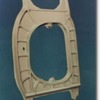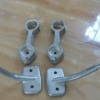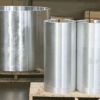Aluminum alloy forging
1.Alloy: 2024 2014 6063 7075 7003 7050
2.Traffic extensively,energy,machinery industry.
Aluminum Forgings | | Aluminum Forgings are generally used in applications where the high integrity of the part is of utmost importance. They are used primarily for structural components such as the intake of Gas turbine engines where light weight is crucial. In automotive applications, forged components are commonly found at points of shock and stress. |
|
Aluminum Alloys | | 2014/2219/2618/5083/6061/7049/7050/7075/7175 And Others |
|
High Strength | | In making a forging, the metal is worked twice under tremendous pressures. First during rod extrusion, drawing or rolling and then during forging. The double working under pressure, compacts the metal, and produces a very dense and refined grain or fiber structure. The tensile strength of the parts is thereby increased, and resistance to impact and abrasion is enhanced. | | Leak Resistance | | The dense non-porous forged metal permits the designer to specify thinner sections without the risk of leaks. Often, the thinner forged parts result in lighter weight and lower piece cost compared to other manufacturing processes. | | Close Tolerances | | A forging produced in a steel die with close tolerances offers several advantages. Overall part dimensions are held closer than in sand casting. Dimensions show minimum variation from part to part allowing for automatic chucking and handling in subsequent operations. The precise designs on the die surface can produce sharp impressions on the forging surface, which is normally not the case with other forming processes. | | Low Overall Cost | | Mass production of forged parts lends itself to maximum savings. However, smaller quantities of copper alloy forgings can also prove economical when specific design parameters must be met. These requirements include leak integrity, close tolerances, high strength with low weight, and non-symmetrical shape. |
|
|
|
Workable Metals | | Aluminum Alloys, 6000 and 7000 series, others upon review | | Forging Techniques | | Closed Die ForgingOpen Die ForgingPrecision Ring Rolling | | Weight Limits | | Dependent upon the part configuration. | | Press Tonnage | | The press size is dependant on the alloy and size of the forging. | | Order Quantity | | Minimum quantities relative to the weight of the part .No limits on large production orders. | | Typical Lead Time | | Based upon material, profile and secondary operations, typically, samples for approval 5 to 6 wks . Airfreight is also available for an expedited delivery. | | Compliances | | All detailed specifications are on our web site or are available on request.Our forgings meet ASTM Specs all materials. | | Quality Assurance | | Chemistry ComplianceElongation TestingFull Dimensional ReportsHardness TestingHeat TreatingMTRs (Material Test Reports/Material Analysis reports)Optical Comparator MeasuringTensile Strength Testing | | Applications | | Archery risers and other parts of bowsArms & Ammunition ProductsClampsCrank ShaftElectrical & Electronic PartsFastenersFire Protection PartsGas Turbine IntakesGear ShaftLighting Products & PartsLock HardwareMarine & Boat PartsMotor parts | | Industries Served | | ArchitecturalBathroomDoor & WindowFastenerFire PreventionIndustrial OEMMarine & NavalOil & GasPump & Valve | |
|
|
aluminum engine forging







